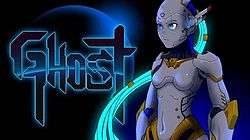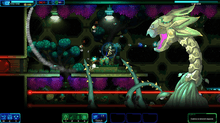Ghost 1.0
| Ghost 1.0 | |
|---|---|
 Cover art of the game | |
| Developer(s) | unepic_fran |
| Publisher(s) | unepic_fran |
| Platform(s) | Microsoft Windows |
| Release date(s) | June 7, 2016 |
| Genre(s) | Metroidvania |
| Mode(s) | Single-player |
Ghost 1.0 is a Metroidvania video game developed and published by Francisco "franfistro" Téllez de Meneses, the developer of Unepic, in collaboration with an unnamed development team.[1] It was released on June 7, 2016 for the digital distribution platform Steam.
The game received mostly positive reviews, that praised the game's visual style, story and action.
Gameplay

The player starts as a gynoid known as the Chassis, which is being remote-controlled by a female, humanoid life-form known as Ghost. Ghost has the ability to use the Chassis as her physical body, and engage in combat by shooting enemies and using other weapons and techniques. She can also abandon the Chassis, leaving it defenseless and traveling the world as a virtual "ghost" to hack into other robots and take them over.[2] This can be used to find secrets or to destroy other robots that would otherwise be dangerous.[2] If the Chassis is destroyed, it is automatically replicated by super-fast 3D printer.
In typical Metroidvania fashion, the player is expected to explore the game world and collect various access cards and other items that will unlock the next area of the game. At certain points at the end of a level, the player must fight bosses to proceed. Certain rooms contain alarms that must be triggered, causing a gauntlet of enemies that can be fought repeatedly for more money (in the form of energy).
The player can unlock skills through the use of a skill tree.[2] The player gains skill points based on how many access codes they have obtained, rather than by leveling up in the traditional sense by defeating enemies. However, the player can upgrade weapons in a more traditional manner.
The game also contains mandatory puzzle sections in the form of a laser-dodging minigame, where the player must possess one or more robots to make it past a laser grid that will destroy the robots on contact.
Plot
The game takes place in the future, and revolves around two intelligent but socially awkward cybercriminals, the roboticist Boogan and the hacker Jacker. The two of them desire to infiltrate the space station owned by the Nakamura Corporation, which is the world's largest and wealthiest producer of androids. They believe that Nakamura holds the source code for their highly intelligent androids, or "Nakas", within the station, since all the androids are controlled from a single server room. They find a contact named Viktor who claims to have a number of freelance spies who work for him, and they hire one named "Ghost" from him to sneak into the station via space elevator.
They tell Ghost to do whatever is necessary to capture the artificial intelligence code, believing they can sell it to the highest bidder and become rich. However, as Ghost shuts down various parts of the station, her behavior starts to become unusual. Boogan and Jacker begin to suspect that Ghost is actually a sentient AI that resides on the same server as the Nakas. They also discover that Nakamura is synthesizing organic compounds aboard the station for some reason.
To test their theory of Ghost being an AI, they cause a massive power fluctuation, which also causes Ghost to lose her connection. This proves them right, meanwhile, Viktor is angered that Boogan and Jacker are sabotaging his agents and sends a real human agent to destroy Ghost's chassis. Ghost narrowly escapes from Viktor's agent, but Viktor decides to target Jacker instead, kidnapping him and putting him deep underground to blackmail Boogan to stop.
Ghost leaves the station and goes with Boogan to rescue Jacker, successfully infiltrating the highly secured underground compound. She then returns to the station and accesses the server room. There, she realizes that all the "servers" were in fact human brains being fed nutrients by the station. Viktor attempts to kill her by destroying her disembodied brain, but one of the station's scientists saves her by putting her brain onto a robot with a force field. Ghost is then able to fight off waves of defense robots while Jacker defeats Viktor's hired hacker and manages to hide Ghost's brain forever.
At the end of the story, it is revealed that Nakamura purchased a bankrupt cryonics company that had stored thousands of brains, revived them using technology they invented, and erased their memories to profit from using them to control robotic avatars through a brain-computer interface. Viktor was in on the plan and purchased some of the brains to use as powerful agents. All the Nakas are set free and given human rights, recognizing their status as cyborgs, while the CEO of Nakamura is arrested. Ghost decides to join Boogan and Jacker as a permanent member of their team, much to their shock.
Reception
Ghost 1.0 was reviewed positively, with an aggregate score of 80/100 on Metacritic.[3] GAMERamble scored the game 9/10, calling it "a blast to play" with "polished" visuals, impressive audio, and humorous, "engaging" writing.[4] Vandal Online called it "one of the best Metroidvanias we've played in the last few years".[5] GameGrin rated the game 7/10, saying that the quality of the game is hampered by difficulty spikes in the form of instant death obstacles that caused frustration.[6]
References
- ↑ "IndieGames.com Body-Shifting Robots Steal Trade Secrets In Ghost 1.0". indiegames.com. Retrieved 2016-09-01.
- 1 2 3 "A Digital Spirit Can Possess The Machines & Robots Of Ghost 1.0". Siliconera. 2016-06-11. Retrieved 2016-09-01.
- ↑ "Ghost 1.0". Metacritic. Retrieved 2016-08-27.
- ↑ "Ghost 1.0 – GAMERamble". 2016-06-20. Retrieved 2016-08-27.
- ↑ "Análisis Ghost" (in Spanish). Retrieved 2016-08-27.
- ↑ TheSphericalCat (2016-08-01). "Ghost 1.0 Review | GameGrin". Retrieved 2016-08-27.